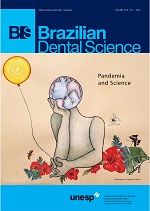Comparison of two oral health-related quality-of-life measures in elderly patients: the influence of missing teeth, and socio demographic factors
DOI:
https://doi.org/10.14295/bds.2020.v23i2.1878Abstract
Objective: The Oral Health Impact Profile-14 (OHIP- 14) and the Geriatric/General Oral Health Assessment Index (GOHAI) have never been compared to a group of the same subjects in the Brazilian population. The aim of the study was to compare the OHIP-14 and GOHAI measures. Material and Methods: 129 independently living people over the age of 60 were included in the study. The GOHAI and OHIP-14 measures were used. Other variables were included: age, gender, education, number of missing teeth, annual household income and frequency of dentist visits. Results: The mean age of respondents was 65 years. The internal reliability (Cronbach’s alpha) showed a high internal consistency for both measures. Spearman’s rank correlation coefficient between the GOHAI and OHIP-14 scores was 0.73. Using the additive method of creating scores, none of the respondents had the GOHAI score of zero, indicating no impact from oral conditions, while 9.3% of them had an OHIP-14 score of zero. Dental status, age, gendler and frequency of dental visit were significantly associated with the results ofthe GOHAI and the OHIP-14 (Kruskal–Wallis test, Mann–Whitney U test). Conclusions: There was a strong correlation between the GOHAI and the OHIP- 14. Both instruments demonstrated good discriminant properties and helped capture the respondents’ oral health problems.
KEYWORDS
Brazil; Older adult; GOHAI; Oral health-related quality of life.
Downloads
Downloads
Published
How to Cite
Issue
Section
License
Brazilian Dental Science uses the Creative Commons (CC-BY 4.0) license, thus preserving the integrity of articles in an open access environment. The journal allows the author to retain publishing rights without restrictions.
=================




























